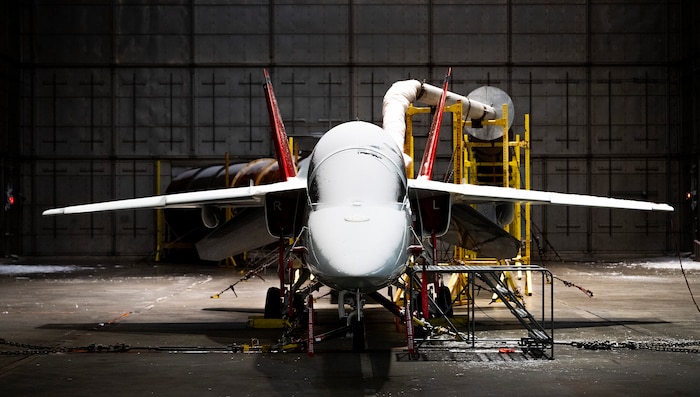The US Air Force (USAF) has announced that the service’s latest trainer aircraft, the T-7A Red Hawk, completed a rigorous month-long trial in extreme weather conditions on February 23.
The success of the T-7A marks a pivotal step to ensure the aircraft’s resilience across a spectrum of weather conditions expected at Air Force training bases around the US.
The T-7A Red Hawk, designed to replace the aging T-38 Talon as the Air Force’s next-generation trainer aircraft, underwent a series of demanding simulations at the McKinley Climatic Laboratory.
According to the Air Force, the lab, known for its capability to replicate various climatic extremes, provided an ideal environment to test the T-7A’s resilience against a wide range of weather conditions.
During the testing period, the Boeing test aircraft endured real temperatures ranging from a scorching 110 degrees to a bone-chilling minus 25 degrees Fahrenheit, along with heavy humidity conditions.
These scenarios were meticulously created within the lab’s expansive 55,000 sq ft test chamber, simulating environments that the T-7A may encounter at training bases across the nation.

Dr. Troy Hoeger, chief development tester for the T-7 with the Air Force Lifecycle Management Center, said, “We need to know the T-7A can operate in the environmental conditions it will encounter at pilot training bases around the country.”
Throughout the testing process, both Boeing and Air Force aircrew conducted system operations and engine runs to evaluate the aircraft’s reactions in various scenarios. Lab technicians worked to create and recreate extreme environments, transitioning from desert heat to freezing temperatures in a matter of days.
Following the completion of climate testing, the T-7A Red Hawk will undergo further evaluation at Boeing to ensure that its technical specifications meet safety standards for operators and maintainers.
The successful completion of climate testing represents a significant step forward in the development of the T-7A Red Hawk trainer aircraft, bringing the Air Force closer to its goal of modernizing its fleet with advanced capabilities for pilot training and readiness.
T-7A Red Hawk Performs Like A Fighter
The T-7A is set to replace the T-38C Talon, bringing about a substantial enhancement in training for upcoming fighter and bomber pilots. It will effectively equip student pilots to progress seamlessly into fourth and fifth-generation fighter and bomber aircraft.
Last September, aerospace titan Boeing delivered the first Red Hawk to the Air Force, bearing tail number APT-2. Subsequently, in November 2023, this aircraft landed at Edwards AFB in California for evaluation purposes. Following this, the company delivered two more examples, designated by numbers APT-1 and APT-3.
Despite facing repeated delays in the development of this trainer aircraft, the service perceives this trainer jet as a vital stride towards modernizing its equipment and bolstering its capability to compete with powerful rivals such as China.
This recognition is underpinned by crucial capabilities inherent in the trainer aircraft. The T-7A is powered by a single GE-F404 turbofan engine, generating approximately 17,200 pounds of thrust.
With features like twin tails, slats, and large leading-edge root extensions (LERXs), the T-7A exhibits adeptness in low-speed handling and agility, resembling the performance of the USAF F-16 but at significantly lower operating and acquisition costs.
In November 2023, a US Air Force official revealed that the service was actively considering a new armed variant of the Boeing T-7A Red Hawk, dubbed the F-7, which could potentially replace older F-16 fighter jets.
Following this announcement, Boeing expressed its enthusiasm for the USAF’s interest in a light-attack version of the T-7 trainer. The company also disclosed that Air Force officials had discussed the concept multiple times.
Once deployed, the T-7A’s open architecture software will render it highly adaptable, allowing for seamless integration of new capabilities and training elements. This flexibility ensures that the aircraft can stay abreast of the broader modernization efforts within the Air Force.
Previously, in his analysis for the EurAsian Times, Amit Gupta, an Associate Professor of Indo-Pacific Studies at the USAF Air University Culture and Language Center, highlighted a shift in global airpower requirements away from expensive fifth or 4.5-generation fighters like the French Rafale, the American F-35 Lightning, or the Eurofighter Typhoon.
Gupta pointed out that the demand for trainer aircraft capable of being armed to function as light fighter jets was growing. He cited examples such as the South Korean FA-50 and the Chinese L-15 trainer jet, which are allegedly being weaponized at a cost of under $20 million.
Many countries seek cost-effective fighter jets that meet their security needs without stretching their budgets thin. Gupta noted the enduring global reputation of the older F-16, which has been employed by countries like Denmark, Pakistan, and Israel with great success in combat. However, newer versions of the F-16 are financially out of reach for most nations.
The Chinese have attempted to fill this gap with the JF-17, sold to Pakistan and Nigeria at relatively low costs. However, the JF-17 has faced challenges in achieving significant export success.
Gupta argued that the T-7A Red Hawk presents an appealing option for countries seeking affordable fighter jets. He further suggested that a weaponized Red Hawk equipped with a capable yet cost-effective radar could meet the needs of many American allies while enabling the United States to counter Chinese and Russian aircraft in regions like South America and Africa.
An armed T-7A Red Hawk possesses the potential to outperform aircraft such as the China-Pakistan-developed JF-17, India’s Tejas, and South Korea’s FA-50 in terms of performance and capabilities.
Further, reports point out that the USAF views the T-7A as a potential next-generation aggressor platform, particularly to provide adversary support for fifth-generation stealth fighters facing limited challenges from small formations of fighters.
With USAF pilots attesting to its fighter-like performance, the T-7A Red Hawk could herald a new era for this aircraft, positioning it as a versatile and cost-effective solution for various airpower needs globally.
- Contact the author at ashishmichel(at)gmail.com
- Follow EurAsian Times on Google News